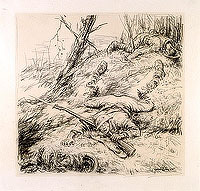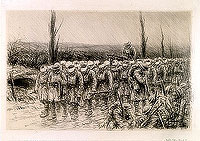Quarterly - FOCUS IN/ON
Anti-War Art: An Overview
- Kerr Eby's Early Life and Training
- Eby's War Experience and His Publication War
- Anti-War Art: An Overview
- Where Do We Go?
- Limiting and Eliminating War: Late 19th and Early 20th Century Efforts
- The Kellog-Briand Pact
- The (Not So) New Order After World War II
- Citizen Movements and Hope
- Suggested Reading


In creating anti-war works, Eby joined a long line of artists stretching back into antiquity who had explored the war theme. Among these can be cited the unknown Egyptian maker of the Palette of Narmer (c. 3000 B.C.), a two-sided relief that was a larger, ceremonial version of palettes used for the grinding of eye paints for sun protection and beautification. The Palette depicts, among other things, the corpses of the victims of the ruler Narmer’s forcible uniting of Upper and Lower Egypt. In ancient Greece, famous battle scenes were frequently depicted by artists in temple sculpture, as in the metopes for the Parthenon in Athens, dating to the fifth century B.C. These nearly square reliefs, running around the exterior in the temple’s frieze (part of the area above the columns and below the roof), include battles between gods and giants, Greeks and Amazons, Greeks and Trojans, and Lapiths and centaurs. In Rome is found the Column of Trajan (erected c. 113 A.D.), with its long, spiraling depiction of that emperor’s army and its battles against Roman enemies; while in Renaissance Italy, Paolo Uccello (c.1397–1475) depicted a Florentine victory in his paintings of The Battle of San Romano (mid-1450s). Images emphasizing the sufferings of war are also to be found, including a series of prints by French artist Jacques Callot (1592–1635) called Miseries and Misfortunes of War, which was published in 1633; and the graphic, gruesome etchings by the Spaniard Francesco de Goya y Lucientes (1746–1828) called The Disasters of War, dating between 1810 and 1820 (published in 1863, after the artist’s death), which commemorated the atrocities done to Spain by Napoleon’s invading forces. Closer to the date of Eby’s images is the well-known anti-war painting of Guernica (1937) by Pablo Picasso (1881–1973), a remembrance of the battle and the sufferings in that city that occurred at the hands of Germans under the direction of Francisco Franco during the Spanish Civil War.
Of these, Goya’s etchings are probably the most related in approach and spirit to Eby’s works, since they include many images of ugly death presented in a matter-of-fact, almost casual way, with titles that frequently understate the horror of the prints to which they apply. Many of the images Eby published in War were ghastly and terrible, such as Mama’s Boy, a drawing depicting a dead, staring-eyed soldier whose legs had been blown off. Another drawing, Pencil Sellers, Class of ’17, is similar to Where Do We Go? in that it features a crowd of soldiers marching along, but in this case most of them have their eyes covered, having been blinded by poisonous gas (the use of mustard gas was particularly prevalent in the war). The drawing’s title refers to the sightless soldiers’ grim prospects for employment following the war. This drawing was published in War with the title given above, although it is inscribed by Eby with the title Match Sellers, Class of ’17.